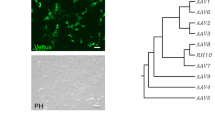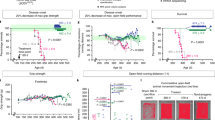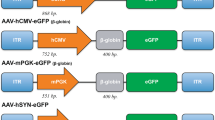Abstract
This study characterized gene transfer into both normal and injured adult rat dorsal spinal cord using first (E1−/E3−) or second (E1−/E2A125/E3−, temperature-sensitive; ts) generation of replication-defective adenoviral (Ad) vectors. A novel immunosuppressive regimen aimed at blocking CD4/CD45 lymphocytic receptors was tested for improving transgene persistence. In addition, the effect of gene transfer on nociception was also evaluated. Seven days after treatment, numerous LacZ-positive cells were observed after transfection with either viral vector. By 21 days after transfection, β-galactosidase staining was reduced and suggestive of ongoing cytopathology in both Ad-treated groups, despite the fact that the immunogenicity of LacZ/Adts appeared less when compared with that elicited by the LacZ/Ad vector. In contrast, immunosuppressed ani- mals showed a significant (P ⩽ 0.05) increase in the number of LacZ-positive cells not displaying cytopathology. In these animals, a concomitant reduction in numbers of macrophages/microglia and CD4 and CD8 lymphocytes was observed. Only animals that received LacZ/Adts and immunosuppression showed transgene expression after 60 days. Similar results were observed in animals in which the L4–L5 dorsal roots were lesioned before transfection. Gene transfer into the dorsal spinal cord did not affect nociception, independent of the adenovirus vector. These results indicate that immune blockade of the CD4/CD45 lymphocytic receptors enhanced transgene stability in adult animals with normal or injured spinal cords and that persistent transgene expression in the spinal cord does not interfere with normal neural function.
This is a preview of subscription content, access via your institution
Access options
Subscribe to this journal
Receive 12 print issues and online access
$259.00 per year
only $21.58 per issue
Buy this article
- Purchase on Springer Link
- Instant access to full article PDF
Prices may be subject to local taxes which are calculated during checkout
Similar content being viewed by others
Author information
Authors and Affiliations
Rights and permissions
About this article
Cite this article
Romero, M., Smith, G. Adenoviral gene transfer into the normal and injured spinal cord: enhanced transgene stability by combined administration of temperature-sensitive virus and transient immune blockade. Gene Ther 5, 1612–1621 (1998). https://doi.org/10.1038/sj.gt.3300774
Received:
Accepted:
Published:
Issue Date:
DOI: https://doi.org/10.1038/sj.gt.3300774
Keywords
This article is cited by
-
Destination Brain: the Past, Present, and Future of Therapeutic Gene Delivery
Journal of Neuroimmune Pharmacology (2017)
-
Neurotrophin treatment to promote regeneration after traumatic CNS injury
Frontiers in Biology (2013)
-
Peripheral Nerve Repair Through Multi-Luminal Biosynthetic Implants
Annals of Biomedical Engineering (2011)
-
A model for long-term transgene expression in spinal cord regeneration studies
Gene Therapy (1999)



